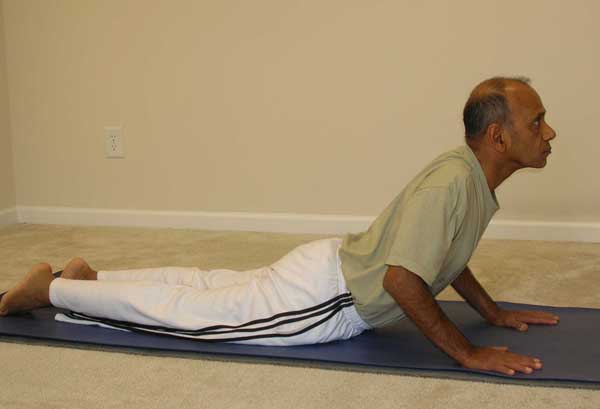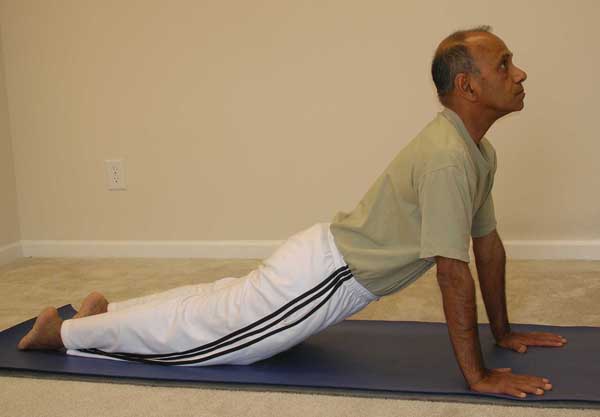
Bhujangasana (Cobra Pose)
An excellent backward bending pose, Bhujangasana –भुजङ्गासन –
The word “bhujanga” in Sanskrit means a cobra or a snake/serpent. In its final position, the pose looks like a cobra with its hood raised and hence the name. In many traditions, the serpent represents the tremendous power latent within the individual. In tantra, it represents the “kundalini shakti” which lies dormant at the base of the spine in the form of a serpent coiled three and a half times. In Hindu mythology it is respected and honored as a sacred animal, symbolizing the individual subtle force, intuition and wisdom. The double looped mathematical symbol for infinity is derived from the ancient symbol of the snake with its tail in its mouth, and is an expression of the continuity and eternity of life. By the practice of bhujangasana, we can realize and express not only all of the specific qualities of the serpent, but also its divine essence.
Step-by-step
I hope you enjoy practicing with the video. In the video, I have demonstrated four different variations of the pose that you can practice. In each variation we try to engage different parts of the spine. In variations one and two, more emphasis is placed on the upper part of the spine. In the other variations, more of the middle and lower spine are engaged.
Variation one:

Bhujangasana (variation 1)
- Lie down on your abdomen with the legs stretched back straight, feet together with the toes pointing away. Bring the palms underneath the shoulders, alongside the body, palms facing down, lining up the tips of the fingers with the tops of the shoulders. Keep the elbows bent and tucked in close to the body.
- While inhaling stretch your head forward and slowly begin to lift your head, neck and chest off the floor. Keep looking upward. Imagine the movement of a snake rising upwards as you do this.
- Lift the hands off the floor slightly and allow the abdominal muscles and the upper spine to do the work of lifting the chest higher with every inhalation. Stay in the final position for 4 to 5 breaths.
- To come out of the pose, while exhaling, slowly lower the chest, neck and forehead down to the floor, bring the arms back alongside the body and relax.
Variation two:
- Repeat steps 1 and 2 as described in variation 1.
- Lift the hands off the floor and bring them behind the back. Interlock the fingers, pulling the hands backwards, try to lift the hands up toward the ceiling. At the same time, allow the abdominal muscles and the upper spine to do the work of lifting the chest higher with every inhalation. Stay in the final position for 4 to 5 breaths.
- To come out of the pose, while exhaling, slowly lower the chest, neck and forehead down to the floor, bring the arms back alongside the body and relax.
Variation three:

Bhujangasana (Cobra Pose)
- Repeat steps 1 and 2 as described in variation 1.
- Keeping the palms on the floor, apply gentle pressure with the palms on the floor and try to lift the chest a bit higher, keeping the navel on the ground. Try to keep the elbows close to the body, lift the shoulders upwards and roll them back. This will give you a good feeling of openness and expansion of the chest.
- Stay in the final position for 4 to 5 breaths.
- To come out of the pose, while exhaling, slowly lower the chest, neck and forehead down to the floor, bring the arms back alongside the body and relax.
Variation four:

Upward Facing Dog (variation 4)
- Repeat steps 1 and 2 as described in variation 1.
- Position the palms vertically under the shoulders. Keeping the palms on the floor, applying a little more pressure with the palms on the floor, straighten the elbows as much as comfortable. Try to keep the shoulders rolled back and lift the chest a bit higher. Make an effort to press the thighs down to the ground. Keep the toes pointing back so the tops of the feet are on the ground.
- If it feels comfortable, you may want to try pressing with the top of the feet (not the toes) and lift the knees of the floor. This variation with the knees lifted up is also called the Upward Facing Dog pose.
- Make sure the elbows are not hyper-extended. Stay in the final position for 4 to 5 breaths.
- To come out of the pose, while exhaling, slowly lower the chest, neck and forehead down to the floor, bring the arms back alongside the body and relax.
Contraindications/Cautions
- Throughout the pose, maintain awareness on the spine and the breath. If at any time you feel discomfort in the spine, wrists or shoulders, you should back off and come out of the pose.
- Avoid practicing Bhujangasana if you suffer from peptic ulcers, hernia, intestinal problems, recent or chronic back injury, carpal tunnel syndrome
- It is not advisable for pregnant women, except for experienced yoga practitioners who can continue to practice it gently during the first trimester.
Benefits
- Builds strength and flexibility in the muscles of the entire back and the shoulders
- Massages the internal organs, especially the digestive organs and the kidneys; affects the adrenal glands, sending them a richer supply of blood
- Relieves constipation
- Helps relieve menstrual problems
- Stimulates and helps balance the swadhisthana (2nd) and manipura (3rd) chakras
- Improves concentration and elevates mood
- Strengthens the arms and shoulders
- Increases overall flexibility
- Firms and tones the buttocks
- Invigorates the heart
- Relieves stress and fatigue
- Opens the chest and helps to clear the passages of the heart and lungs
- Soothes sciatica
- Helps to ease symptoms of asthma
I would love to hear your own experience with Bhujangasana. Do you practice it as a standalone pose or as part of the Surya Namaskara sequence? What benefits have you derived with this pose? Do drop a line in the comments block.
thank you so much for this amazing video
Thanks for your kind feedback.